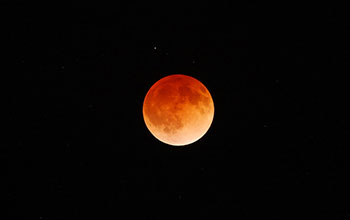Multimedia Gallery
"Blood moon" (Image 1)
A lunar eclipse took place April 15, 2014.
A lunar eclipse occurs when the moon passes directly behind the Earth into its umbra (shadow). This can occur only when the sun, Earth and moon are aligned exactly, or very closely so, with the Earth in the middle. Hence, a lunar eclipse can occur only the night of a full moon. Unlike a solar eclipse, which can be viewed only from a certain relatively small area of the world, a lunar eclipse may be viewed from anywhere on the night side of the Earth.
Nicknamed a "blood moon," this lunar eclipse's color was similar to the majority of lunar eclipses. This has to do with the Earth's atmosphere's propensity for longer-wavelength light (e.g., the reds, oranges and yellows seen in sunrises and sunsets).
"The study of the color of lunar eclipses can be used to understand dust in the stratosphere including the amount and particle size of dust injected by volcanic eruptions," says Stephen Pompea, an astronomer at the National Optical Astronomy Observatory. "Understanding the amount of dust can help scientists create better models of climate change." (Date image taken: April 15, 2014; date originally posted to NSF Multimedia Gallery: Nov. 12, 2015) [Image 1 of 4 related images. See Image 2.]
Credit: Stephen Pompea, NOAO
Images and other media in the National Science Foundation Multimedia Gallery are available for use in print and electronic material by NSF employees, members of the media, university staff, teachers and the general public. All media in the gallery are intended for personal, educational and nonprofit/non-commercial use only.
Images credited to the National Science Foundation, a federal agency, are in the public domain. The images were created by employees of the United States Government as part of their official duties or prepared by contractors as "works for hire" for NSF. You may freely use NSF-credited images and, at your discretion, credit NSF with a "Courtesy: National Science Foundation" notation.
Additional information about general usage can be found in Conditions.
Also Available:
Download the high-resolution JPG version of the image. (3.4 MB)
Use your mouse to right-click (Mac users may need to Ctrl-click) the link above and choose the option that will save the file or target to your computer.



